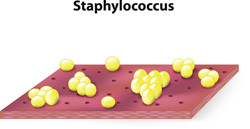Antibodies for Staphylococcus infections
S. aureus is an important human pathogen associated with hospital and community-acquired infections. It can cause severe and potentially fatal health complications, such as endocarditis or septicaemia, as well as infect implanted medical devices. Injudicious use of antibiotics has led to the emergence of methicillin resistant S. aureus (MRSA). MRSA shows low susceptibility even to broad-spectrum antibiotics and has a diverse repertoire of immune evasion strategies. As such, there is an urgent need to develop novel therapeutic interventions. The administration of combinatorial monoclonal antibodies is gaining ground as an alternative treatment. The EU-funded COMPSTAPH project set out to generate such human antibodies to neutralise the virulence of S. aureus. Project activities concentrated on the immune-evasion and virulence-promoting extracellular fibrinogen-binding (Efb) protein. To validate the mechanism of action of Efb, researchers developed an ex vivo model of blood S. aureus infection (bacteraemia) which recapitulates the human condition. They found that addition of Efb increased pathogen survival by rendering the pathogen 'invisible' to the immune system. Human antibodies against Efb were isolated following a thorough screening of an antibody library. To identify which antibodies blocked Efb binding with the complement protein C3d, scientists set up a competition ELISA assay. The most effective antibody candidates were tested in the bacteraemia model to identify lead molecules with therapeutic efficacy. To evaluate if these antibodies could be used as a multivalent vaccine, the consortium screened their efficacy in an in vivo model of kidney infection. Treatment of mice with just a single dose of blocking antibodies significantly lowered bacterial burden in infected kidneys and reduced inflammation. These antibodies remained in circulation and were functional for at least 36 hours, supporting their further exploitation in other disease models. Collectively, the findings of the COMPSTAPH study support the validity of passive immunisation through the delivery of antibodies as an effective strategy against S. aureus infection. Considering the dismal outcome of S. aureus infections, a therapeutic vaccine is long overdue.







